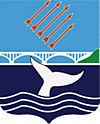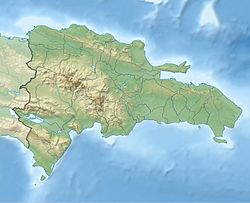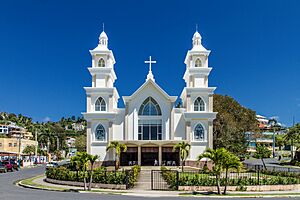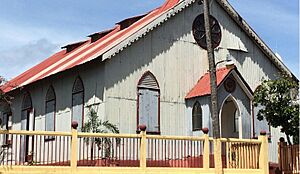Samaná (town) facts for kids
Quick facts for kids
Samaná/Xamana
|
||
|---|---|---|
| Santa Bárbara de Samaná/Saint Barbara of Samana | ||
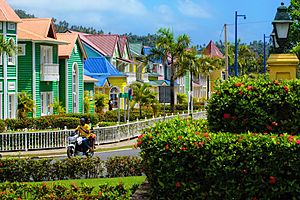
Samaná neighborhood (2011)
|
||
|
||
| Country | Dominican Republic | |
| Province | Samaná | |
| Founded | 1756 | |
| Municipality since | 1865 | |
| Area | ||
| • Total | 412.11 km2 (159.12 sq mi) | |
| Elevation | 5 m (16 ft) | |
| Population
(2012)
|
||
| • Total | 108,179 | |
| • Density | 262.500/km2 (679.873/sq mi) | |
| • Demonym | Samanés/ Samana American | |
| Municipalities | 3 | |
Samaná (also called Santa Bárbara de Samaná) is a lively town in the northeastern part of the Dominican Republic. It's the main city of the Samaná Province and sits right on the northern coast of Samaná Bay. Samaná is a very popular place for tourists, especially because it's the best spot in the Caribbean to go whale-watching.
The town of Samaná includes three smaller areas called municipal districts. These are El Limón, Las Galeras, and Arroyo Barril. In 2012, a count of the people living there showed that the whole area had a population of 108,179.
Contents
Geography of Samaná
Samaná is located on a small flat area near the coast. However, most of the town is built on the hills that surround this flat land.
How Big is Samaná?
Samaná is the largest municipality in its province. It covers a total area of 412.11 square kilometers. This is almost half of the entire province's area. This total includes the three municipal districts that are part of Samaná.
Mountains in Samaná
Most of the land in Samaná is covered by the Sierra de Samaná. This is a short mountain range with steep sides. Even though the slopes are steep, the mountains are not very high. The tallest mountain in this range is called Monte Mesa, which is 605 meters high.
Population of Samaná
People who live in Samaná, whether in the city or the wider province, are called Samanés. This name is used for both men and women. Sometimes, you might also hear them called Samanense.
History of Samaná
The town of Santa Bárbara de Samaná is on the Samaná Peninsula. This area first appeared in written history on January 13, 1493. This was when Christopher Columbus made his last stop here during his first trip to the New World.
Columbus's Visit
Columbus landed on what is now known as Rincón Beach. There, he met a group of native people called the Ciguayos. They were the only group who fought back against Columbus during his visit to the Americas. The Ciguayos did not want to trade their bows and arrows, which Columbus's explorers wanted. During the fight, two native people were hurt. Because the Ciguayos used arrows, Columbus named the area the Bay of Arrows. Columbus took four native people with him to show in Spain, but only one survived the journey. For a long time after this, the Spanish did not build many settlements here. This made the area a hiding place for people who had run away and for privateers (sailors who attacked ships for their own gain).
Founding the Town
In 1756, a Spanish governor named Francisco Rubio y Peñaranda helped families from the Canary Islands to settle here. They founded the village and named it Santa Bárbara de Samaná. It was named Santa Bárbara after Queen Bárbara de Braganza, who was the wife of King Ferdinand VI of Spain. These families also settled on the other side of the bay, in Sabana de la Mar.
Changes in Control
In 1796, the entire Santo Domingo colony, including Samaná, was given to the French as part of a peace agreement. However, in 1807, a small group from the British Royal Navy attacked Samaná. They gave it back to the Spanish people who were fighting against the French. In 1822, the Haitians took control of the entire island. A French ship then threatened to start fighting again between the French and Haitians. After a small event called the Samaná Affair, the French left. They took several families with them who had moved back to Samaná after the Haitian Revolution.
Samaná Americans
In 1824, the Haitian President Jean-Pierre Boyer invited Black people from the United States to move to Haiti. At that time, Haiti ruled the entire island of Hispaniola. Many families from the U.S. settled in Samaná and did very well. Their descendants are known today as Samaná Americans. In 1865, Samaná became a municipality when the Samaná Maritime District was created. This was an old type of division similar to a province.
Economy of Samaná
The main ways people make money in Samaná are through tourism, farming, and fishing. The biggest boost to the local economy happens from January to March. This is when thousands of North Atlantic humpback whales come to the Samaná Bay to have their babies. Samaná becomes the main center for tourism in the country during these months because of the whale watching.
Climate in Samaná
Samaná has a warm and wet climate. The average amount of rain each year is about 2,349.8 millimeters. The average temperature throughout the year is 26.5 degrees Celsius.
| Month | Jan | Feb | Mar | Apr | May | Jun | Jul | Aug | Sep | Oct | Nov | Dec | Year |
|---|---|---|---|---|---|---|---|---|---|---|---|---|---|
| Record high °C (°F) | 33.0 (91.4) |
34.0 (93.2) |
36.0 (96.8) |
36.0 (96.8) |
35.2 (95.4) |
37.0 (98.6) |
39.2 (102.6) |
37.0 (98.6) |
37.0 (98.6) |
38.5 (101.3) |
36.0 (96.8) |
35.0 (95.0) |
39.2 (102.6) |
| Mean daily maximum °C (°F) | 29.2 (84.6) |
29.5 (85.1) |
30.2 (86.4) |
30.7 (87.3) |
31.5 (88.7) |
32.5 (90.5) |
32.6 (90.7) |
32.7 (90.9) |
32.6 (90.7) |
32.2 (90.0) |
30.6 (87.1) |
29.6 (85.3) |
31.2 (88.2) |
| Mean daily minimum °C (°F) | 19.1 (66.4) |
19.3 (66.7) |
19.9 (67.8) |
20.6 (69.1) |
21.8 (71.2) |
22.8 (73.0) |
23.1 (73.6) |
23.0 (73.4) |
22.7 (72.9) |
22.2 (72.0) |
20.6 (69.1) |
19.6 (67.3) |
21.2 (70.2) |
| Record low °C (°F) | 15.0 (59.0) |
15.0 (59.0) |
14.5 (58.1) |
16.0 (60.8) |
16.0 (60.8) |
19.0 (66.2) |
19.0 (66.2) |
19.0 (66.2) |
19.0 (66.2) |
18.5 (65.3) |
17.0 (62.6) |
15.5 (59.9) |
14.5 (58.1) |
| Average rainfall mm (inches) | 145.7 (5.74) |
109.5 (4.31) |
116.6 (4.59) |
141.8 (5.58) |
231.5 (9.11) |
152.2 (5.99) |
185.1 (7.29) |
229.2 (9.02) |
193.3 (7.61) |
246.9 (9.72) |
257.2 (10.13) |
202.9 (7.99) |
2,211.9 (87.08) |
| Average rainy days (≥ 1.0 mm) | 15.6 | 11.7 | 10.5 | 9.9 | 15.0 | 13.7 | 16.7 | 17.7 | 15.7 | 17.2 | 18.5 | 17.6 | 179.8 |
| Source: NOAA | |||||||||||||
Famous People from Samaná
Many talented people have come from Samaná, including:
- Manny Albam (1922-2001), a jazz saxophonist.
- Wily Peralta (born 1989), a baseball pitcher who played for the Milwaukee Brewers.
- Hanley Ramírez (born 1983), a baseball first baseman who played for the Boston Red Sox.
- Fernando Rodney (born 1977), a baseball pitcher who played for the Seattle Mariners.
- Yordano Ventura (1991-2017), a baseball pitcher who played for the Kansas City Royals.
- Théodore Chassériau (1819-1856), a famous French painter, was born in El Limón in 1819.
- Brayan Bello (born 1999), a baseball pitcher who plays for the Boston Red Sox.
Getting to Samaná: Transport
Samaná has two airports that make it easy to travel there:
- The international airport is called Samaná El Catey International Airport. It is about 40 miles by road from the city.
- There is also a smaller airport for flights within the country, called Arroyo Barril Airport. This one is closer, about 10 miles from the city by car.
See also
 In Spanish: Samaná para niños
In Spanish: Samaná para niños


